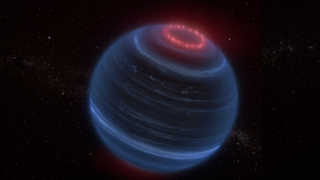A newly discovered rogue stellar body may well be a ‘failed star’, but it’s certainly not a failure in terms of speed!
The potential brown dwarf is hurtling through our Milky Way galaxy at a speed of 1.9 million kilometers per hour. That’s about 1,500 times faster than the speed of sound! Fortunately, this cosmic escape is heading toward the center of the Milky Way, not toward us. However, the object is moving so fast that it could eventually escape our galaxy altogether.
The incredible speed of this newly discovered stellar body, designated CWISE J1249+3621, isn’t the only fascinating thing about the object, which is currently about 400 light-years from Earth.
This stellar body has a mass about 8% of the Sun’s, or 80 times the mass of Jupiter, which places it right on the dividing line between a star and a fascinating group of objects called “brown dwarfs,” often (somewhat unfairly) labeled “failed stars.”
CWISE J1249+3621 was originally discovered by citizen scientists working with the Backyard Worlds: Planet 9 project, which uses data from NASA’s Wide-field Infrared Survey Explorer (WISE) to detect faint, moving objects relatively close to the sun.
Related: Hubble Space Telescope Reveals ‘Failed Stars’ Have Relationship Problems Too
After several citizen scientists reported the object, a team of astronomers followed up using the Keck I telescope, one of twin 10-meter telescopes located on the dormant volcano Maunakea in Hawaii.
“We’ve discovered a very low-mass object, right on the border between the mass of a star and a brown dwarf, that has extreme velocity and is moving fast enough that it could be independent of the Milky Way,” Adam Burgasser, the research team leader from the University of California, San Diego, told Space.com. “It joins a series of ‘hypervelocity’ stars that have been discovered in the last few decades, most of which are thousands of light-years from the Sun, while this source is only 400 light-years away.”
Burgasser added that the team’s observations included an analysis of CWISE J1249+3621’s atmosphere. This indicated that the potential brown dwarf also had an unusual chemical composition. The team wanted to use the information gathered about CWISE J1249+3621’s motion and composition to speculate about its possible origins.
“This discovery opens a new avenue for studying brown dwarfs that are located in distant regions of the Milky Way, including its center, its halo, and its various globular clusters and satellites,” Burgasser said. “All of these systems are too distant to study brown dwarfs directly in detail, but if they are sent to us, it’s much easier!”
What is this rogue star running from?
Brown dwarfs form like stars: from giant clouds of gas and dust, called molecular clouds, that develop dense areas that collapse under their own gravity. However, unlike a regular star like the Sun, brown dwarfs fail to gather enough material from the remnants of the cloud that spawned them to reach the mass needed to generate the pressures and temperatures in their cores that trigger the fusion of hydrogen into helium. This process is what defines a “main sequence” star. Hence the nickname “failed star” imposed on brown dwarfs.
Brown dwarfs have masses ranging from about four times that of Jupiter to about 80 times that of the gas giant. (For comparison, the Sun is 1,000 times more massive than Jupiter.) The mass of CWISE J1249+3621 is exciting because it places it right on the hypothetical boundary between a star and a brown dwarf.
“Its low mass is important because it is by far the smallest and fastest star ever discovered to date. The hypervelocity stars discovered about 20 years ago were massive O-type stars (about 50 times more massive than the Sun) and B-type stars (up to 16 times more massive than the Sun), a likely selection bias because these stars are rare and expected to be found at large distances,” Burgasser said. “Our discovery indicates that the process(es) that cause these stars to escape must operate at both high and low masses.”

The UC San Diego researcher explained that the team was really excited to try to figure out what sent this stellar body hurtling across the Milky Way.
“The star may have been ejected from the center of the Milky Way by our supermassive black hole, Sagittarius A*, a process commonly used to explain the origins of other hypervelocity stars,” Burgasser said. “It is noteworthy that our star is moving toward the center, not away from it, but it may be returning after being ejected earlier.”
He added that it was also possible that the brown dwarf was on the run from a “cosmic vampire.” The rogue stellar body could have been part of a binary system with a white dwarf stellar corpse that was sucking material out of it. This horrific feeding would eventually cause the white dwarf to erupt in a cosmic explosion called a Type Ia supernova. This would destroy the white dwarf and provide the “kick” that would send the runaway dwarf hurtling across the Milky Way at incredible speeds.
“Another possibility is that the star was thrown out of a globular cluster by dynamical interactions with black holes at the cluster’s center; recent simulations show that this should happen many times over the age of the Milky Way,” Burgasser said. “Any of the above processes, given a fast enough nudge, could have ejected it, or in the case of an ‘extragalactic’ star, it could have simply passed through.”
He added that, for now, the team cannot rule out the possibility that this potential brown dwarf is an intruder into our galaxy from outside the Milky Way. But the fact that it crosses the plane of our Milky Way makes that case less likely.
“The orbit of this object is probably the most surprising aspect: it moves radially in and out of the center of the Milky Way and almost perfectly in the plane,” Burgasser said. “Most of the high-velocity stars we observe are in much more chaotic or inclined orbits. I think that’s a real clue to its true origin.”
Related: Brown Dwarfs: The Coldest Stars or the Hottest Planets?

Fugitive brown dwarfs, if that is indeed what CWISE J1249+3621 is, appear to be rare, but this could be due to their cool and faint nature, which makes them difficult to detect. This means that the population of fugitive brown dwarfs could be much larger than current detection rates indicate.
“These types of stars are extremely rare; only a few dozen have been discovered out of billions of stars examined, and as we’ve said before, this is the first low-mass star. And this particular object is hard to see because it’s a very cool, faint star, nearly 10,000 times fainter than the Sun and emitting most of its light in infrared wavelengths,” Burgasser said. “It’s hard to say how common these bodies are, with only one having been discovered so far, but because this one is so close, we suspect there could be many more.”
“This speculation is partly based on the fact that the majority of stars in the Milky Way are low-mass, and about one in five are brown dwarfs, and these objects are the easiest to “move” because of their low mass.”
The team now plans to continue studying CWISE J1249+3621’s atmosphere in more detail to see if its chemical abundances reveal anything about its origin. They will also try to discover more of these low-mass stellar escapees, a hunt in which citizen scientists will play a key role.
“We definitely want to find more of these objects, and our citizen scientists have identified several other high-velocity candidates to follow up on,” Burgasser concludes. “Citizen scientists have been absolutely essential to this study! They’re the ones who identified this source as an interesting target worth studying. Without them, we’d still have hundreds of thousands of tiny weak spots to sort through.”
The team’s research is discussed in a pre-peer-reviewed paper submitted to the arXiv repository.